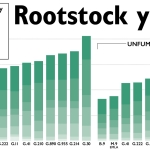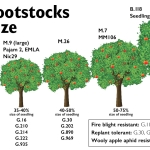
Geneva 210, a more vigorous rootstock than Malling 9 or G.41, yielded just as well in untreated ground as in fumigated ground in a replant trial in Wapato, Washington. (Geraldine Warner/Good Fruit Grower)
A new rootstock trial being planted in five sites in Washington State this spring should provide more insights into how Geneva apple rootstocks will perform in replanted orchards in the Pacific Northwest.
The trial, being planted in Oroville, Brewster, East Wenatchee, Wapato, and Prosser, will include G.969, which has not yet been tested in the Pacific Northwest.
The rootstock is highly resistant to woolly apple aphid and fire blight, and has tolerance to replant disease. Cornell has ranked it as one of the most vigorous of the Geneva rootstocks released so far, similar to Malling 7 in vigor.
However, results from previous trials in Washington State suggest that Geneva rootstocks tend to produce smaller trees than when grown in the eastern United States, where they were developed.
Before commercial release, the Cornell rootstocks are classified with the prefix CG (Cornell Geneva) and a four-digit number, the first of which denotes its relative size. So, for example, G.969 was called CG.6969 before release, meaning its vigor was rated 6 on a scale of 1 to 9.
Dr. Gennaro Fazio, breeder and geneticist at the U.S. Department of Agriculture’s Plant Genetic Resources Unit in Geneva, where the rootstocks were developed, said the vigor rating is just an estimate, because soil, climate, and scion can also affect rootstock vigor.
Two scions are used in the new trial in Washington—Gala and Red Delicious. Tom Auvil, research horticulturist with the Washington Tree Fruit Research Commission, stressed that the reason for including Red Delicious is its extreme sensitivity to replant disease so that the rootstocks will be put to the ultimate test. The plots will have two treatments—fumigated and non-fumigated.
The ten Geneva rootstocks in the trial include G.890 (CG.5890) and G.210 (CG.6210), which should come onto the market soon. They recently came out of tissue culture and are being propagated by nurseries now. Auvil, who is heading the trials in Washington, said those two rootstocks are about 40 to 45 percent the size of a seedling tree and are resistant to fire blight and woolly apple aphid.
Though larger than Malling 9, these rootstocks could have a place in modern plantings, Auvil said. “I think that, looking down the road towards automated harvest and multiple-leader trees, we have the ability to have rootstocks with a little more horsepower and yet excellent crop density to allow thinner production systems and high yields.”
The new trial also includes G.11 (CG.3011), G.30 (CG.5030), G.41 (CG.3041), G.935 (CG.5935), and G.214 (CG.4214) along with the new selections CG.4011 and CG.5257. The standard rootstocks Budagovsky 9, M.9 Nic 29, and M.9 T337 are included for comparison.
Fazio said nurseries have asked for CG.4011 and CG.5257 to be sent to the National Clean Plant Network for certification and testing, and his unit is providing certified material for large-scale testing. They are both relatively easy to propagate. CG.5257 is resistant to woolly apple aphid, but CG.4011 is susceptible. They are both resistant to fire blight. They are very precocious and seem to do well in replant situations.
A new rootstock nearing release, which is not included in the trial, is G.814 (CG.4814), which Fazio said has several interesting traits. It is productive, cold hardy, resistant to fire blight, tolerant of replant disease, provides a good amount of calcium to the scion, and is easy to propagate. However, it has the same failing as G.16—it is susceptible to one or two latent viruses.
“The virus issue on this rootstock is going to be a deciding factor on who propagates it, because we will need assurance that the nurseries and growers know how to handle it,” Fazio said.
Older trial
Earlier this year, Auvil led a tour of a 10th-leaf trial of disease-resistant and replant-tolerant rootstocks in Wapato, with Gala as the scion.
The trees have cropped heavily for the past three years. Yields from trees on M.9 have plateaued but yields from trees on most of the Geneva rootstocks have continued to increase.
They are looking healthy and vigorous, whereas those on M.9 are looking tired, Auvil pointed out. Some trees on B.9 in the unfumigated treatment didn’t make it past the first two or three years, lacking enough bearing surface to support the crop.
G.11 is a weaker rootstock than M.9 but has overtaken M.9 in the fumigated plot, producing 293 bins per acre over the first seven years. However, it is not tolerant of replant disease.
G.41, a slightly larger rootstock than M.9, outyielded M.9 in both fumigated and unfumigated treatments with yields of 307 and 227 bins respectively.
G.210, which is more vigorous than M.9 and G.41, has performed surprisingly well in replant conditions, Auvil reported. Cumulative yields in the first seven years were the equivalent of 312 bins per acre in the fumigated plot and 328 bins per acre in unfumigated ground. In comparison, cumulative yields on M.9 EMLA were 253 bins from fumigated trees and only 176 bins from unfumigated.
G.30 has also proven reliable in unfumigated ground, but its future may be limited because of the difficulties nurseries have in propagating it. In almost all the trials that the Research Commission has conducted, trees on G.30 have consistently been the highest yielding, Auvil said. At the Wapato trial, cumulative yields on that rootstock were 412 bins per acre in fumigated ground and 371 bins per acre in unfumigated. “But it’s a miserable thing to grow in the nursery,” he said.
G.890 is similar to G.30 in vigor. In a trial of a similar age in Brewster, Washington, with Fuji as the scion, it’s done extremely well in light soils and difficult replant conditions, Auvil reported. •








Leave A Comment